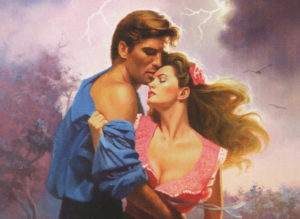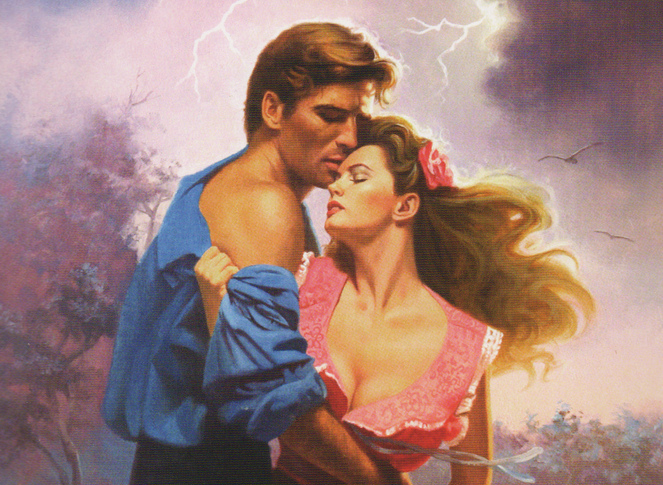
Jazmyne St. Champagne’s heaving bodice due to Volcano Barritz rocking her world makes erotica seem ingenue, but its roots are an esteemed literature genre.
In 2011, E. L. James published her novel “Fifty Shades of Grey” that quickly turned into a worldwide phenomenon and movie franchise.
Unlike other series that had a similar upbringing (including “The Hunger Games” by Suzanne Collins and “Fifty Shades” inspiration “Twilight” by Stephanie Meyer), “Fifty Shades” set itself apart because of its blush-inducing content.
The story focuses on Anastasia Steel, a college senior who interviews wealthy businessman Christian Grey for a friend. Soon afterward, the two begin a romance that is punctuated with Christian’s preference for BDSM as a means for sexual arousal.
While “Fifty Shades of Grey” may have catapulted erotica into mainstream culture, it doesn’t exist on its own as sexually promiscuous material.
“There has never been a time devoid of recorded human sexuality,” Emily D. Wicktor, a current NDSU professor of English, said. “Those human desires and urges — for food and sex — are key components of recorded human history and evidence what is essential for human survival. Cave drawings gave way to inkwells, to printing presses, to photographs, to film, to digital communications, to virtual reality. In the history of recorded human activity, each subsequent technological advance creates new spaces for recording, marketing, expressing and capturing human sexuality.”
Wicktor earned her Ph.D. in English in 2010, particularly studying Victorian pornography. She is currently working on a manuscript about the topic.
“The Victorian Era, and 19th-century literature and culture in general, is dominated by both real and fictional ‘fallen woman’ narratives. In these narratives, a young, naive female is seduced by a male cad who impregnates and abandons her,” Wicktor continued. “Pregnant and unmarried, she must endure the public shame of a ‘sexual transgression’ she cannot hide, and she must endure the scorn of bearing a bastard child. The fallen woman usually dies a martyr or kills herself in service of saving her child’s reputation.”
This isn’t exactly the same as modern erotic literature, but like Wicktor said, erotica, like all genres, is a “heterogeneous one, filled with variation and subgenres.” What marks erotica as obscene or not is the ambiguous legal terminology, including “community standards.”
“The potentially contestable areas of debate regard sexual subject matter and the connection to obscenity laws and what constitutes obscene content, as obscenity regulations are tied to legal language regarding what the ‘average person’ would call offensive, or what ‘community standards’ would deem as lacking artistic or scientific merit or value,” Wicktor said. “These latter considerations, of course, construct erotica and pornography under legal definitions, as well as under somewhat nebulous ‘community standards’ that can shift and change with cultural and social development.”
While you may scoff and snicker at people you see reading “Fifty Shades of Grey,” many works of fiction including James Joyce’s “Ulysses” was once considered sexually obscene and Anaïs Nin’s “Delta of Venus” is in the same genre as the “Twilight” fanfiction.
“Add to this the very long history of grocery-store-aisle Harlequin Romance content, wherein characters named Jazmyne St. Champagne and Volcano Barritz engage in all manner of pulsing and heaving and sweating, one can see why some might not take this particular type of erotica seriously,” Wicktor said.
From racy cave paintings to blush-worthy Victorian pornography and now to the modern age of E. L. James’ “Fifty Shades of Grey” and X-rated movies, erotica as a literary genre and pornography as a means of sexual expression have followed humans through recorded history. But it’s not quite over yet.
“Not only are there more avenues to easily access sexually explicit subject matter, but there are more mediums in which we are free to create our own erotic or pornographic content,” Wicktor concluded. “Sure, several might malign the quality of E. L. James’ erotica, but it’s undeniable that she wrote herself into a cultural moment that wanted her particular type of fantasy. I don’t think we’re done with this process. I think we’re merely adding new ways to create, share and access this content that might speak to a cultural expression of human desire.”
Sexually explicit content can be found in all forms, including movies, television, visual arts and finally, literature.
While erotic culture has grown and adapted to its cultural setting and technological innovations, humans have always been expressing their carnal desires. These expressions may be rife with heaving bodices, like in Harlequin Romance, or they could feature BDSM and wealthy businessmen like in “Fifty Shades of Grey.” Either way, the world of erotic fiction has room to grow.
